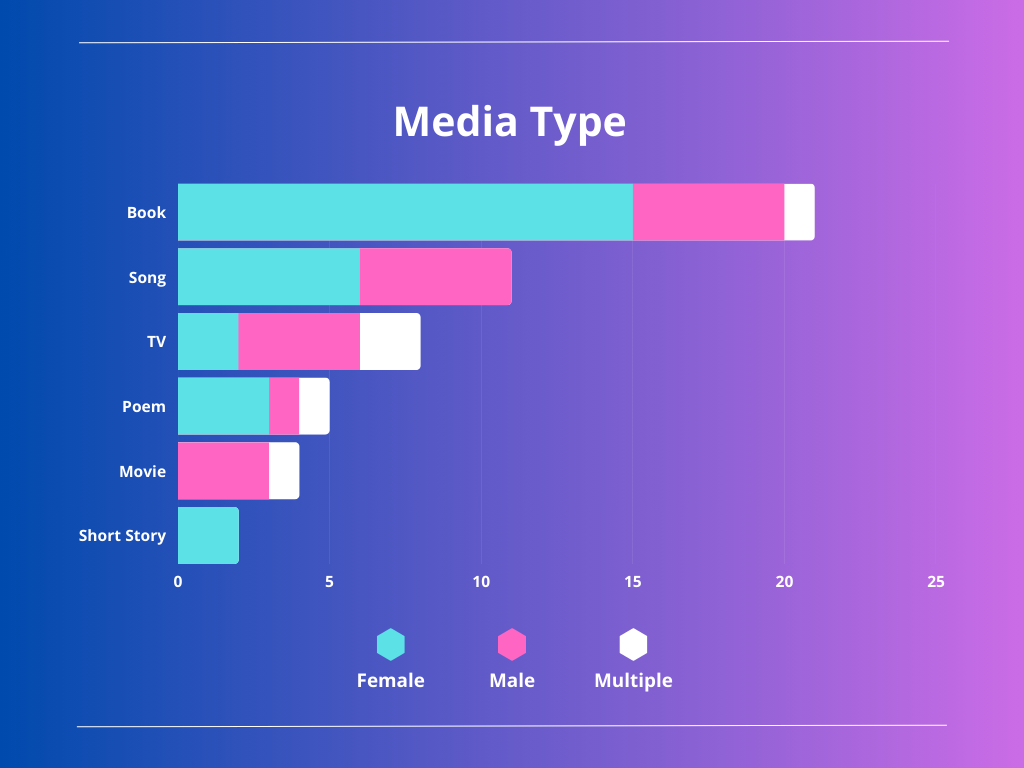Analysis: Media, Gender, and OCD
There are some caveats to this section. First of all, I am using men and women as a binary here. This is not because gender exists in a binary, or that people outside the binary can’t have OCD. I, myself, identify as a nonbinary person with OCD. Unfortunately, the media representation that I found only existed within the binary, and so that is the framing that is used in this piece. This ties into the next piece, which is the categories themselves. These categories are not meant to be directly representative of the entire lived experience of people with obsessive-compulsive disorder. Other/unspecified is a very common category in both obsessions and compulsions, and that is because even within the media, these categories of obsessions and compulsions are not the end-all be-all of OCD. Still, they are useful for noticing overarching trends. Please read this post not as a prescription of facts, but as an overview of what OCD can look like in media and how it might vary based on gender. With that said, there are some trends here that are useful starting points to larger conversations surrounding gender and obsessive-compulsive disorder.
Obsessions
There are some interesting trends to take note of in obsessions. Contamination is the largest category represented in men with ten works, while women are represented in seven works about contamination. This distribution is fairly equal. Similarly, just right obsessions are divided at six for women and six for men, while other/unspecified is seven for women and six for men. This trend continues with some exceptions. Harm and Pure-O obsessions are only represented in women, while real event/false memory obsessions are only represented in men. Due to how small the sample is for all of these categories, it’s probably most accurate to attribute it to that rather than any gendered representation. However, Women are most represented in responsibility/checking obsessions at ten, while men are represented in only two. This category is one with a relatively higher sample size that shows a stark difference in representation across gender, which feels worth noting.


Compulsions
Unspecified/Other is the most common category here, with a fairly equal distribution across genders. Some of these are because of very specific compulsions highlighted that didn’t fit within the primary compulsions. For the most part, this category was so common because some types of works (especially songs) simply don’t mention compulsions as clearly, whereas a book has more time to display these behaviors. Because of that, compulsions simply weren’t represented equally in all media. Regardless, between compulsions and obsessions, compulsions showed much stronger variation between genders in the most common categories. Counting was much more common in women at ten to two. Interestingly, cleaning is more common in OCD depictions in men at eight to three. The latter is especially worth noting, given that cleaning is seen a traditionally feminine behavior. It feels possible that this is exactly why it’s more common as a compulsive behavior; It simply isn’t seen as remarkable when it presents in women, whereas it’s more of a novelty to exhibit excessive cleaning/washing behaviors. Counting is less explicitly gendered behavior, but it is worth noting that ten out of thirteen of the works with counting were books, and fifteen out of twenty one of the books included represent women with OCD. So media genre may be another factor in this.
Media
Speaking of media, that is another place with interesting gendered trends. With twenty-one books total, fifteen of which feature a woman/girl with OCD, books are the primary medium of what’s being made with OCD at the center. Songs are next up with a fairly even divide of 6 women and five men with OCD represented. Poems are also primarily women, with three women and one man with OCD represented, and the two short stories are both about women as well. The only ones that are primarily men are in TV, with four to two, while all four movies are focused on men (The one with multiple features a woman with OCD as the love interest, but it is still centered around the man). Overall, representation is 54.9% women, and 35.3% men.

So... Why do we still think of men when we think of OCD?
The media the above sections is based off of the database I have gathered. But I also put out a call for submissions from other people on what media they thought of when they thought of OCD. The demographics of media are especially noteworthy. While the database is 41.2% books, submissions were only 25% books. No songs were submitted, in comparison to 21.6% in the database. TV and movies each accounted for 33.3% of the total submissions, compared to 15.7% and 7.8% respectively in my own data. Monk, a TV show, and As Good As It Gets, a movie, were both submitted more than once. So we can see that despite accounting for a small amount of the total works containing OCD, TV and media representation is the most known generally. And those categories are the only categories that are predominantly men, with only two TV shows centering a woman with OCD and no movies. This brings in how important it is to account for not only the overall trends in all works collected, but which of those works are the most perceived as representation. Despite being the smaller subset of representation, works featuring men were also the 83% of the works submitted. So representation is not simply what is represented, it’s also how it’s represented, and what stories are being lifted the highest. The representation is out there, but you have to look beyond what’s initially being made visible.